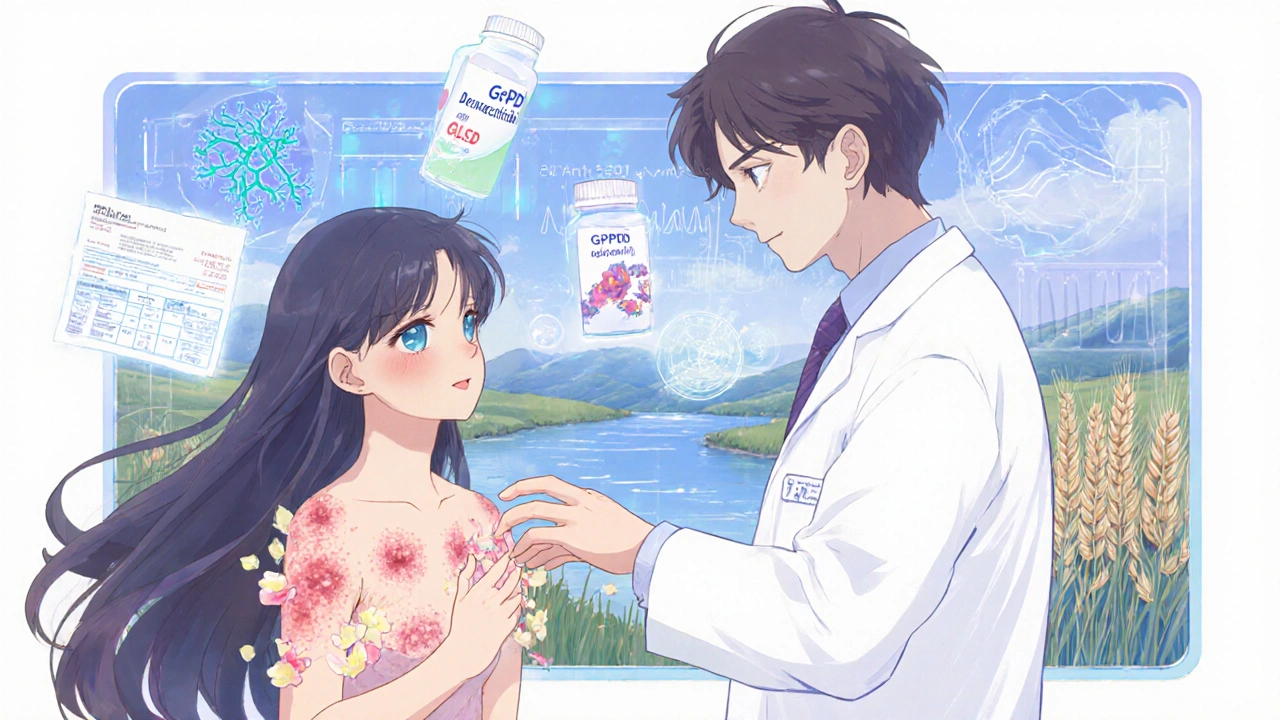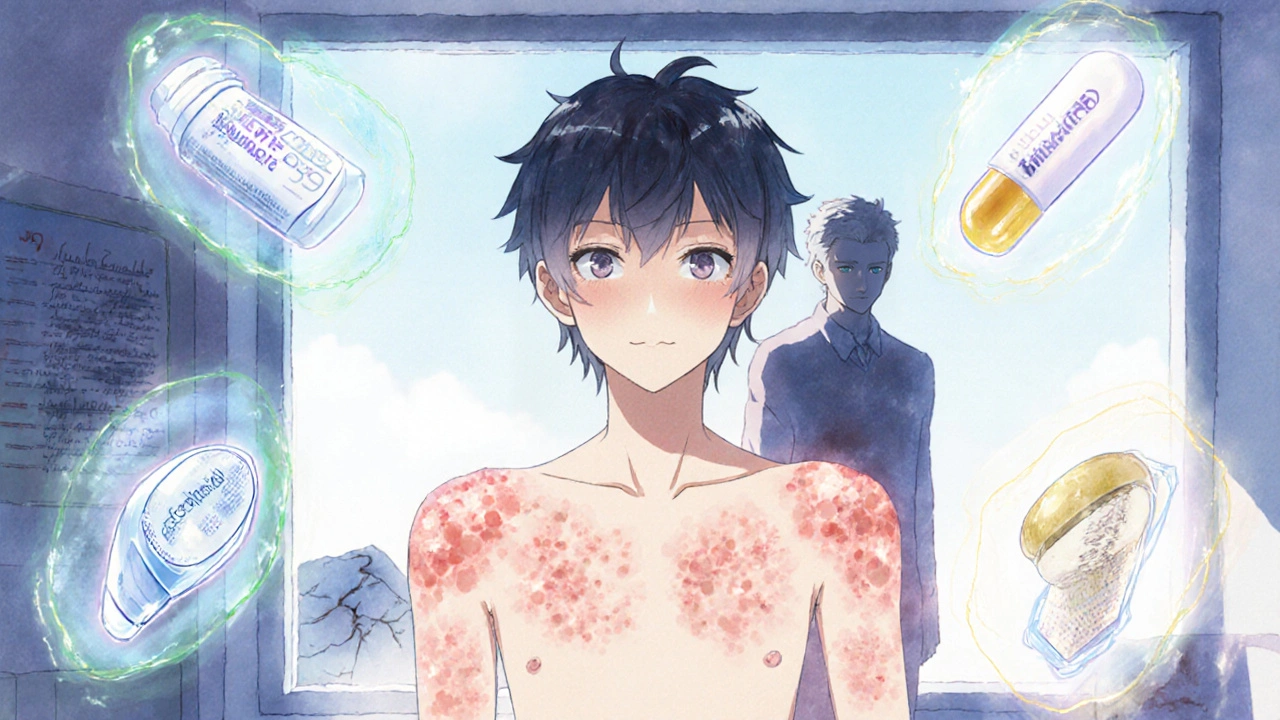Dapsone has been used for over 70 years to treat skin conditions like dermatitis herpetiformis and leprosy. It’s also prescribed for certain types of pneumonia and chronic blistering diseases. But it’s not the only option anymore. Many patients and doctors are now looking at newer, safer, or more effective alternatives - especially when Dapsone causes side effects like anemia, nerve damage, or severe rashes.
How Dapsone Works and When It’s Used
Dapsone belongs to a class of drugs called sulfones. It works by reducing inflammation and killing certain bacteria and parasites. It’s not an antibiotic you’d use for a sore throat - it’s targeted. The most common uses today are:
- Dermatitis herpetiformis (a gluten-related skin rash)
- Leprosy (as part of multi-drug therapy)
- Chronic bullous dermatosis of childhood
- Some forms of pneumonia in people with HIV
For dermatitis herpetiformis, Dapsone often clears up the itchy, blistering rash within days. But it doesn’t fix the root cause - gluten intolerance. That’s why patients still need a strict gluten-free diet even while taking it.
For leprosy, Dapsone is almost always used with rifampicin and clofazimine. Using it alone risks the bacteria becoming resistant. That’s why it’s never prescribed by itself for leprosy anymore.
Common Side Effects of Dapsone
Many people tolerate Dapsone well at low doses. But side effects are common, especially at higher doses or with long-term use:
- Headaches and dizziness
- Nausea and vomiting
- Blue-tinged skin or lips (methemoglobinemia)
- Low red blood cell count (hemolytic anemia)
- Peripheral neuropathy (tingling or numbness in hands and feet)
- Severe skin reactions like Stevens-Johnson syndrome
People with G6PD deficiency are at high risk for dangerous anemia from Dapsone. That’s why doctors often test for this before prescribing it. If you’ve had a bad reaction to sulfa drugs in the past, Dapsone might not be safe for you either.
Top Alternatives to Dapsone
When Dapsone isn’t working, isn’t tolerated, or carries too much risk, here are the most common and effective alternatives:
1. Sulfapyridine
Sulfapyridine is the closest relative to Dapsone. It’s also a sulfone drug and works similarly for dermatitis herpetiformis. It’s less commonly used today because it’s not as potent, and it can cause more stomach upset. But for patients who can’t take Dapsone due to blood-related side effects, it’s a viable option. Doses are usually higher - around 1-2 grams per day - and it takes longer to work.
2. Colchicine
Colchicine is best known for treating gout, but it’s also effective for dermatitis herpetiformis and other blistering skin conditions. It works by calming inflammation, not by killing bacteria. It’s safer for people with G6PD deficiency since it doesn’t cause hemolytic anemia. Side effects include diarrhea, nausea, and muscle pain, but these often improve with dose adjustments. Many patients switch to colchicine after experiencing Dapsone-related anemia.
3. Rituximab
Rituximab is a biologic drug used for autoimmune diseases like rheumatoid arthritis and some lymphomas. It’s not a first-line treatment for skin conditions, but it’s been used successfully in severe, treatment-resistant cases of dermatitis herpetiformis and bullous pemphigoid. It’s given as an IV infusion and costs thousands of pounds per dose. It’s usually reserved for patients who’ve failed multiple other treatments. The benefit? It can induce long-term remission. The downside? It suppresses the immune system and increases infection risk.
4. Tetracycline Antibiotics (Doxycycline, Minocycline)
These antibiotics are often used for acne and rosacea, but they also have strong anti-inflammatory effects. For mild to moderate dermatitis herpetiformis, doxycycline (100 mg twice daily) can be as effective as Dapsone, with fewer blood-related risks. It’s often combined with nicotinamide (a form of vitamin B3) to boost results. This combo is popular in the UK because it’s affordable, widely available, and has a good safety profile. It takes 4-6 weeks to see full results, though.
5. Corticosteroids (Topical and Oral)
Topical steroids like clobetasol are used for short-term relief of itchy, inflamed skin. They don’t cure the condition but can calm flare-ups quickly. Oral steroids like prednisone are used only for severe, acute cases - not for long-term control. Long-term steroid use brings its own risks: weight gain, bone loss, high blood sugar, and mood changes. They’re a bridge, not a solution.
Comparison Table: Dapsone vs Alternatives
| Drug | Best For | Dosing | Onset of Action | Main Risks | Cost (UK) |
|---|---|---|---|---|---|
| Dapsone | Dermatitis herpetiformis, leprosy | 25-100 mg daily | 1-7 days | Anemia, neuropathy, methemoglobinemia | £10-£30/month |
| Sulfapyridine | Dermatitis herpetiformis (Dapsone-intolerant) | 1-2 g daily | 1-4 weeks | Stomach upset, rash | £15-£40/month |
| Colchicine | Dermatitis herpetiformis, G6PD deficiency | 0.5-1 mg daily | 1-3 weeks | Diarrhea, muscle pain | £5-£20/month |
| Doxycycline + Nicotinamide | Mild to moderate skin inflammation | 100 mg twice daily + 500 mg 2-3x daily | 4-6 weeks | Sun sensitivity, upset stomach | £10-£25/month |
| Rituximab | Severe, treatment-resistant cases | IV infusion, 375 mg/m² weekly x 4 | 4-12 weeks | Infection, infusion reactions, immune suppression | £5,000-£10,000 per course |
| Topical Clobetasol | Short-term flare control | Once or twice daily on affected skin | 1-3 days | Thinning skin, stretch marks, rebound flares | £10-£20/tube |
Which Alternative Is Right for You?
The best choice depends on your condition, medical history, and tolerance for side effects.
If you have dermatitis herpetiformis and a history of anemia or G6PD deficiency, colchicine or doxycycline with nicotinamide are safer starting points. Many UK dermatologists now prefer this combo because it avoids blood tests every few weeks.
If you’ve tried everything else and your rash is still raging, rituximab might be an option - but only under specialist care. It’s not something your GP can prescribe.
If you’re being treated for leprosy, you won’t be switching out Dapsone alone. It’s part of a three-drug combo. If you can’t tolerate Dapsone, your doctor will replace it with clofazimine or rifampicin, not a skin-focused alternative.
For short-term relief, topical steroids help - but don’t use them for more than two weeks without supervision. They mask the problem, not fix it.
What to Do If Dapsone Isn’t Working
Don’t stop Dapsone suddenly. That can cause a rebound flare. Talk to your doctor about:
- Getting a G6PD blood test if you haven’t had one
- Checking your hemoglobin and liver function every 2-4 weeks
- Trying a lower dose first - sometimes 25 mg daily is enough
- Switching to colchicine or doxycycline if side effects are mild
- Referring to a dermatology specialist if you’re not improving after 8 weeks
Some patients find that combining treatments helps - like using topical steroids for flare-ups while taking oral doxycycline for long-term control. That’s something your doctor can tailor to your needs.

What’s New in 2025?
In 2025, research is focusing on targeted therapies that block specific inflammation pathways. One promising drug in late-stage trials is deucravacitinib, originally developed for psoriasis. Early data shows it reduces skin lesions in dermatitis herpetiformis without affecting blood cells. It’s not approved yet, but if it gets licensed, it could become a game-changer - especially for patients who can’t take Dapsone or steroids.
Another area of growth is personalized dosing. Blood tests now help doctors adjust Dapsone doses based on how fast your body breaks it down. This reduces side effects and improves results.
Frequently Asked Questions
Can I take Dapsone if I’m allergic to sulfa drugs?
No. Dapsone is chemically similar to sulfa antibiotics. If you’ve had a serious allergic reaction to sulfonamides like sulfamethoxazole, you should avoid Dapsone. Reactions can include severe rashes, fever, or organ damage. Tell your doctor about any sulfa allergy before starting treatment.
Is Dapsone safe during pregnancy?
Dapsone is classified as Pregnancy Category C. Animal studies show harm to the fetus, but human data is limited. It’s only used during pregnancy if the benefit clearly outweighs the risk - usually for leprosy or life-threatening skin conditions. Always discuss alternatives with your doctor if you’re pregnant or planning to be.
How long do I need to take Dapsone for dermatitis herpetiformis?
Most people take Dapsone for at least 6-12 months. Some stay on it longer if their rash returns when they stop. But the real goal is to manage symptoms while following a strict gluten-free diet. Over time, many patients can reduce or stop Dapsone entirely - but only under medical supervision.
Can I drink alcohol while taking Dapsone?
It’s best to avoid alcohol. Both Dapsone and alcohol can stress the liver. Drinking while on Dapsone increases the risk of liver damage and may worsen side effects like dizziness or nausea. Even moderate drinking isn’t recommended.
What should I do if I miss a dose of Dapsone?
If you miss a dose, take it as soon as you remember. But if it’s almost time for your next dose, skip the missed one. Don’t double up. Missing doses can cause your rash to flare or reduce the drug’s effectiveness. Set phone reminders if you’re on long-term treatment.
Next Steps and When to See a Specialist
If you’re currently on Dapsone and experiencing side effects, schedule a review with your GP or dermatologist. Ask for blood tests - especially a full blood count and G6PD screening. If you’ve been on Dapsone for more than 6 months without improvement, it’s time to consider alternatives.
If your skin condition is worsening, spreading, or affecting your quality of life, don’t wait. A dermatology specialist can offer advanced treatments like biologics or newer oral therapies that aren’t available through general practice.
Remember: Dapsone saved lives in the 1950s. But medicine has moved on. Today, safer, more targeted options exist. You don’t have to live with side effects if better choices are out there - you just need to ask for them.

Sage Druce
October 28, 2025 AT 17:39Patrick Dwyer
October 30, 2025 AT 08:13Tyler Mofield
October 31, 2025 AT 23:23Bart Capoen
November 1, 2025 AT 16:33luna dream
November 1, 2025 AT 22:52Linda Patterson
November 1, 2025 AT 23:01Jen Taylor
November 2, 2025 AT 17:19Shilah Lala
November 4, 2025 AT 04:11Christy Tomerlin
November 5, 2025 AT 21:37Susan Karabin
November 6, 2025 AT 13:35Lorena Cabal Lopez
November 7, 2025 AT 15:17Stuart Palley
November 8, 2025 AT 09:15Glenda Walsh
November 8, 2025 AT 17:16